Resources
 Part of the Oxford Instruments Group
Part of the Oxford Instruments Group
Expand
Collapse
 Part of the Oxford Instruments Group
Part of the Oxford Instruments Group
Historically in visible cameras a global shutter architecture was combined to either low readout speed or high noise. In scientific CMOS imaging, low noise was achieved with rolling shutter architectures. The ANDOR CB1 camera line from First Light Imaging overcomes this performance compromise. No need to choose, you can get it all: global shutter, low noise and high speed!
ANDOR CB1 was born from the need of scientists to have a flexible highspeed, low noise, global shutter “snapshot” camera for high-end low light visible applications. Integrating the new generation of Sony CMOS Pregius™ sensors, the camera achieves high framerate and high sensitivity without any compromise.
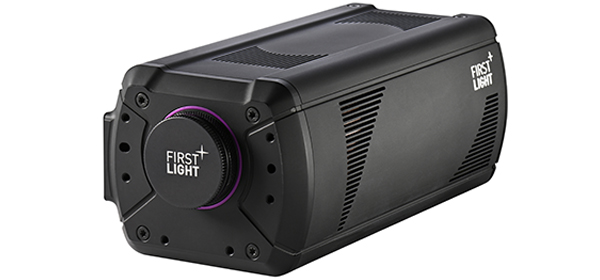
Andor CB1 camera
To offer the latest sensor design and a wide portfolio of scientific cameras, the architecture of ANDOR CB1 has been designed to integrate one of three sensors with different characteristics. This vision ensures to have the ideal product for any applications.
Rolling shutter uses simpler pixel architecture than global shutter. Hence usually, rolling shutter is less noisy than global shutter, this is why this architecture is used in scientific applications but with all its drawbacks.
In ANDOR CB1, global shutter, high speed and low noise are combined without compromise, which is unique in the scientific imaging camera portfolio offer. The integration of the sensors in a scientific grade camera with ultra low noise electronics, scientific grade glass, extensive stabilization and cooling possibilities magnifies their performances. With an extremely low noise, the camera enables imaging and sensing in ultra low light conditions.
First Light Imaging offers the user full control over the camera parameters to enable optimized tuning, fulfilling the requirements of the most demanding applications. All modes offered by the sensor (windowing, high dynamic range, etc.) and all optimizations (glow reduction, etc.) are implemented. ANDOR CB1 features all essential functionalities for scientific applications such as external triggering, variable digitization depth, variable gain, increased framerate with windowing, and many more.
The camera uses CXP 2.0 or GigE interface to transfer the large amount of data generated each second and to ensure the lowest latency and highest real time capability. The camera is fully supported by our proprietary software First Light Vision and the Software Development Kit. Compatible with Windows® and Linux®, it provides extensive examples in MatLab®, LabVIEW®, Python, etc.
ANDOR CB1 is a high-speed, low noise, global shutter camera
dedicated to scientific applications. To meet your exact requirements
you can choose between three different high-end sensors.
The acquisition mode is an intrinsic characteristic of the sensor. For a CMOS, there are two ways to acquire an image:
1. Rolling shutter. The acquisition is made one line after the other, the sensor reads each line of the array sequentially. Pixels are exposed with a temporal shift from one line to the next.

2. Global shutter. The full array is exposed entirely at once. All the pixels begin and end the exposure simultaneously. At the end of exposure, the image is transferred to the memory. Then, the image is read-out while the next one is being exposed.
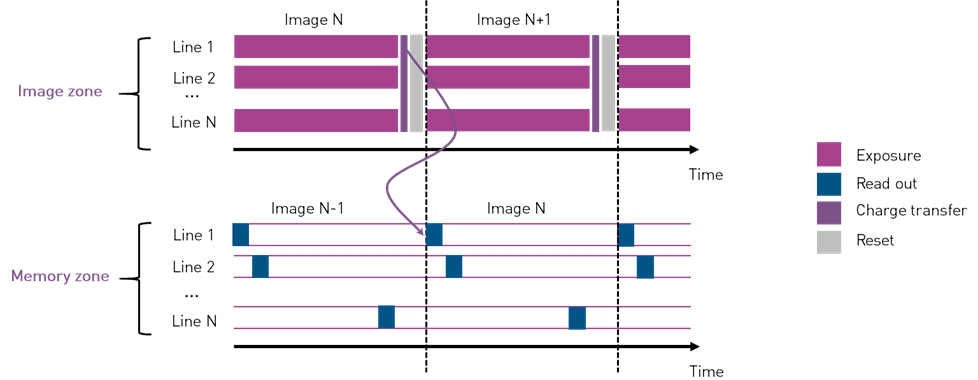
It is important to understand the differences that will occur in an experimental context when using a camera with rolling or global shutter. Global shutter is highly advantageous for dynamic imaging applications. Let’s see why.
Artefact free. In rolling shutter when the image readout speed cannot match the object’s motion, there is temporal under sampling. A spatial distortion of the object, often referred to as the ‘rolling shutter effect’, appears. On the images on the left, significant spatial distortion of the fan propellers is visible in rolling shutter. The larger the object and the faster the movement, the worst is the distortion. Additionally, as the sensor gets larger and with a higher resolution, the readout will take longer, hence, the distortion will get worse. This artefact is different from motion blur which occurs in both global and rolling shutter when the integration time is too long compared to the object’s speed.
Temporal correlation. Even in the absence of distortion the top and the bottom of an image acquired in rolling shutter will not be captured at the same exact time point. Different regions of the image are not correlated in time to other regions. Whereas with global shutter, all pixels are exposed at the same time, allowing for accurate temporal correlation of different areas of the sensor.
Simpler and faster synchronization. Synchronizing a rolling shutter camera to other components, such as a light source, can be difficult due to the time delay between the lines of the sensor. This may result in slower cycle times and frame rates relatively to those achievable in global shutter.
Specifically designed to address the scientific market and benefiting from First Light Imaging’s expertise in high end scientific cameras (EM-CCD, CMOS, MCT, InGaAs), the ANDOR CB1 range offers numerous assets for imaging. Below is an insight into the features common to the full range of cameras.
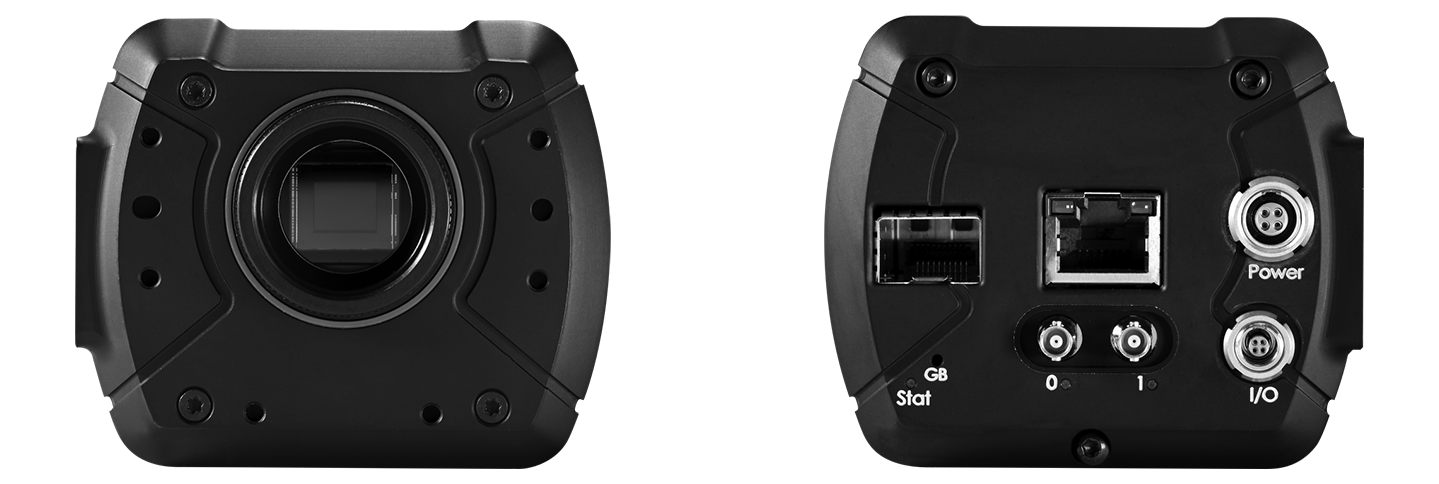
ANDOR CB1 camera front and back views
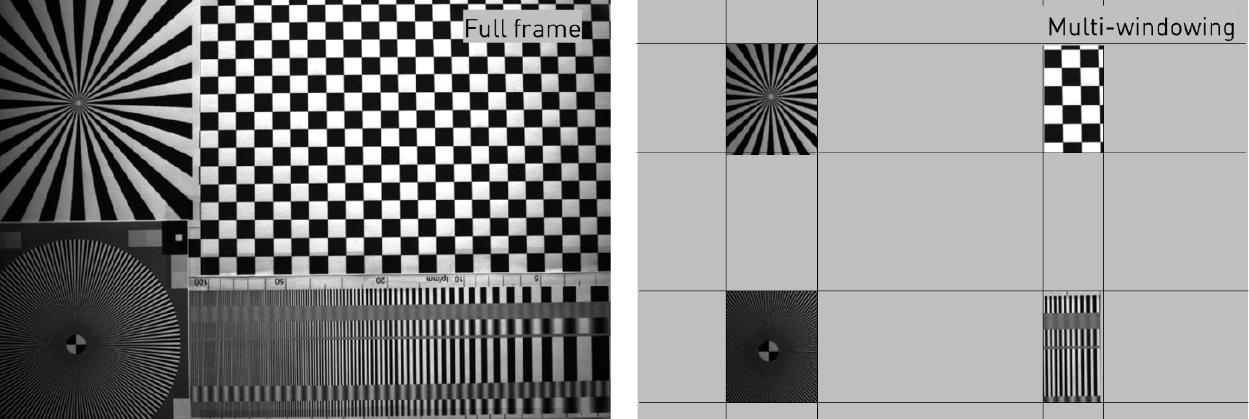
By allowing you to choose your framerate versus resolution versus detectivity compromise, ANDOR CB1 is a flexible solution for multiple applications. The key differentiating features of each camera version are summarized below.
| ANDOR CB1 0.5 | ANDOR CB1 1.7 | ANDOR CB1 7.1 | |
| MORE SPEED | BEST COMPROMISE | MORE PIXELS | |
| Sensor type | 1.7” | 1.1” | 1.1” |
| Diagonal | 9.2 mm | 17.6 mm | 17.6 mm |
| Resolution | 0.5 MP (812 x 612) | 1.7 MP (1608 x 1104) | 7.1 MP (3216 x 2232) |
| Framerate | 8 bits : 1594.7 fps 12 bits : 941.4 fps |
8 bits : 662.1 fps 12 bits : 481.4 fps |
8 bits : 207.1 fps 12 bits : 134.5 fps |
| Pixel pitch | 9 µm | 9 µm | 4.5 µm |
| Detectivity | ++ | ++ | ++ |
The resolution of a camera refers to the number of pixels in the sensitive array. The combination of resolution and pixel pitch defines the dimension of the sensor and hence the field-of-view of the camera
The figure illustrates the field of view of a 17.6 mm diagonal sensor versus the field of view of a 9.2 mm diagonal sensor (same optics).
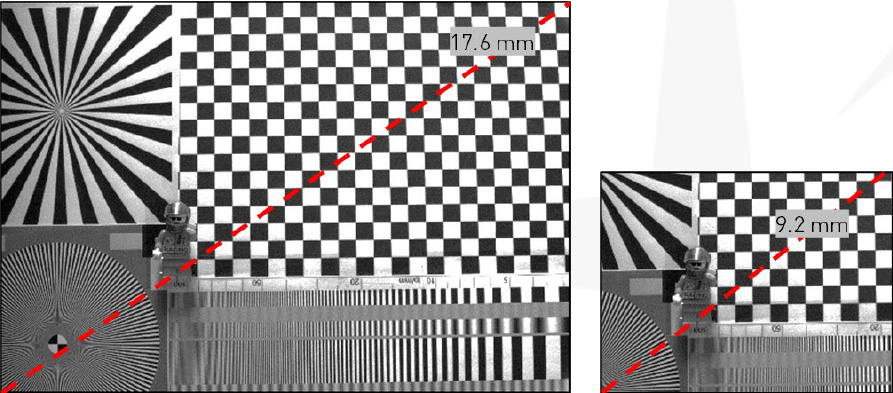
The pixel pitch of a sensor is the side dimension of each individual pixel. The smaller the pixel, the finer the details of the image which can be captured. However, one must keep in mind that the detectivity of the camera is improved with larger pixels.
Have you ever wondered what was written on Lego-Bob’s shirt? The cropped images on the right are acquired with a 9 µm pixel pitch camera versus a 4.5 µm pixel pitch camera (same optics).
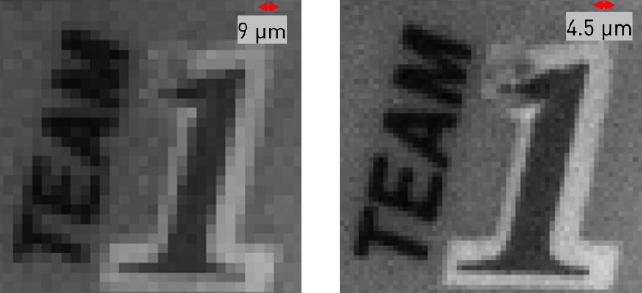
The framerate, also commonly called the speed of a camera is a consequence of the bandwidth of the data transfer (expressed in Gbits/s) and the size of each image (product of the number of pixels by the bit depth).
The graph on the left shows how framerate increases with line cropping for each camera in 12-bits configuration. Remember that speed is higher in 8-bits.
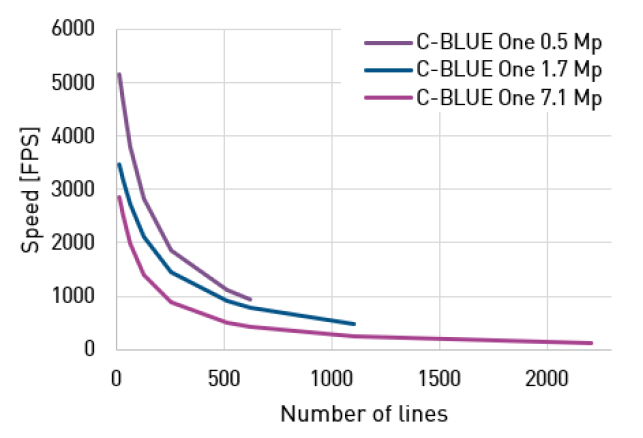
* typical values
Let’s now focus on the performances of the cameras…
Spectral efficiency: Based on silicon CMOS, the spectral sensitivity of the cameras offers high quantum efficiency in the visible range, and some efficiency in the UV range.
| ANDOR CB1 |
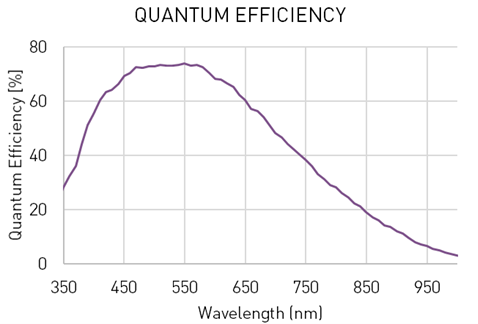 |
The performances of the ANDOR CB1 are characterized in 12 bits configuration. The camera conversion gain and analog gain enable to tune the camera to various full well to readout noise compromises. In the following tables we will focus on the High Sensitivity mode (High gain 24 dB analog gain) and the High Full Well (Low gain 0 dB analog gain). The simultaneous large full well and low readout noise offer a high dynamic range for all cameras, which can be further enhanced in HDR mode.
Dark noise. The camera is cooled for long exposure and low-light applications. Cooling ensures that the dark current signal and associated noise is kept minimal. At 10°C, the very low dark current enables ultra-long exposures. Combined to a very limited glow from the detector, exposure times up to 10 000 s are possible!
| ANDOR CB1 0.5 | ANDOR CB1 1.7 | ANDOR CB1 7.1 |
| 1.4 e-/p/s | 1.0 e-/p/s | 0.24 e-/p/s |
Linearity. The sensors all have a non-linearity below 1% and high spatial uniformity, enabling quantitative imaging. The table below sums up the full wells
| ANDOR CB1 0.5 | ANDOR CB1 1.7 | ANDOR CB1 7.1 | |
| High gain 24 dB | 1150 e- | 1150 e- | 650 e |
| Low gain 0 dB | 94 000 e- | 94 000 e- | 23 000 e- |
Readout noise. With a very low readout noise enhancing the sensitivity, ANDOR CB1 provides high signal-to-noise ratios in demanding applications. The table below presents the readout noise distributions in High Sensitivity mode.
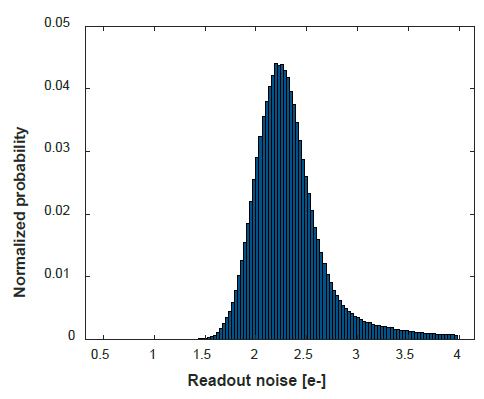
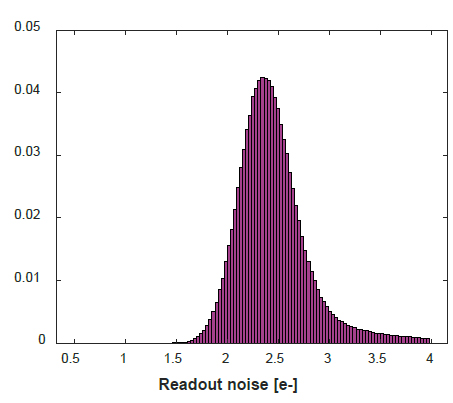
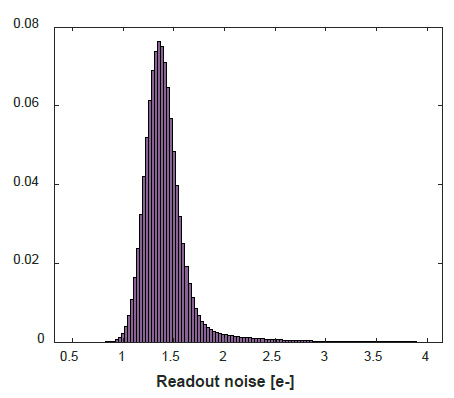
The combination of high speed, low noise and a global shutter architecture in the ANDOR CB1 cameras makes them a game changer for a wide range of demanding applications.
Initially, the ANDOR CB1 camera was developed for Laser Guide Star (LGS) wavefront sensing astronomy: debris tracking, adaptive optics assisted satellite tracking, ground based space situational awareness, space debris de-orbitation, etc.
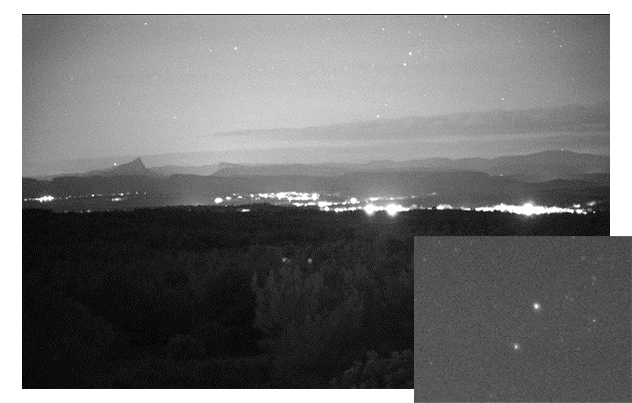
Detection of stars on a moonless night.
Camera: ANDOR CB1 1.7 Mp.
Objective lens: 35 mm f/1.4
Designed for industrial use the ANDOR CB1 sensor performances are optimized by their integration in a scientific camera. This unique combination enhances the possible application of the camera to high-end industries, such as semiconductor inspection, monitoring optical components quality, failure analysis, solar panel inspection, etc
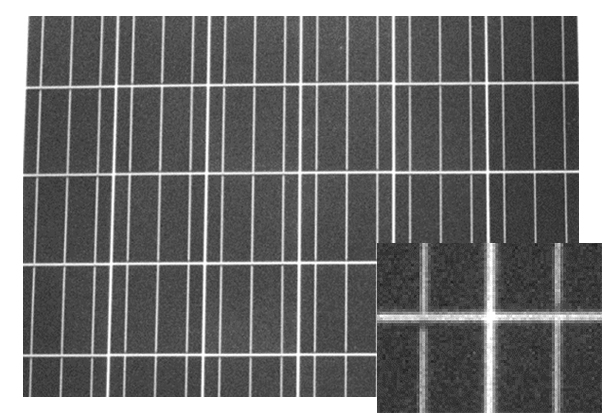
Imaging of solar panel cells.
Camera ANDOR CB1 1.7 Mp.
Objective lens: 35 mm f/1.4.
Fluorescence and bioluminescence imaging including super-resolution localization microscopy require high sensitivity cameras to detect the low emission of fluorophores. ANDOR CB1 can also be used for wide field microscopy, for example for high content and high throughput screening, DNA and forensic analysis, biometrics etc.
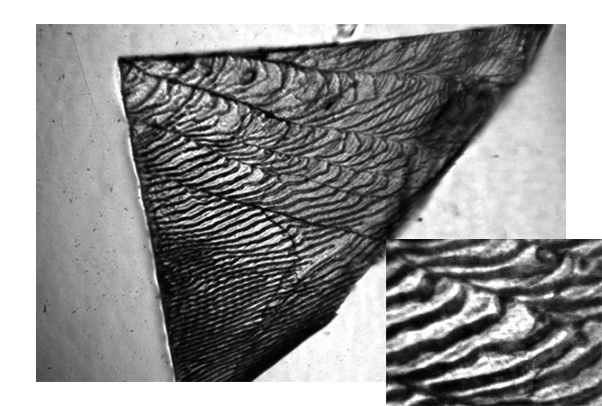
Microscopy image of a fish skin sample.
Camera ANDOR CB1 1.7 Mp.
Custom 10x microscope.
Multiple research applications can benefit from the performances of ANDOR CB1. Dynamical studies such as motion analysis, particle image velocimetry, etc. will take advantage of the high resolution and high speed without any motion artefacts thanks to the global shutter architecture.
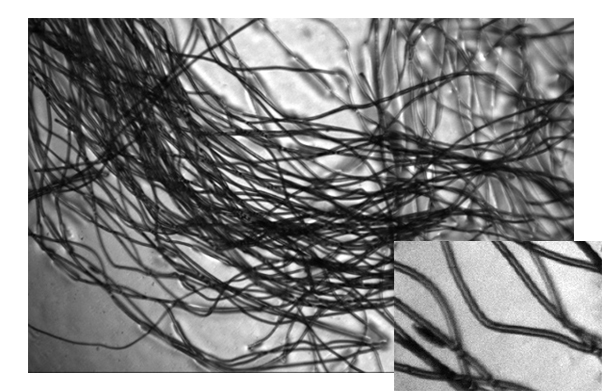
Microscopy image of a wool fiber sample.
Camera ANDOR CB1 1.7 Mp.
Custom 10x microscope.
The flexible design of ANDOR CB1 is a major asset for the user. With a common design, extensive cooling capacities (down to 0°C stabilization and possible cooling plate adaptor), the camera boosts the performances of robust industrial sensors to their limit. The global shutter architecture of the sensor is a key feature for all applications with fast motion or dynamics. With ANDOR CB1, simultaneously and for the first time a global shutter architecture and low noise is made possible, which is a major improvement for fast acquisition scientific applications.
You can get it all!
With ANDOR CB1 you have high speed and low noise
with a global shutter sensor.
| ANDOR CB1 1.7 Pixel pitch : 9 µm Resolution : 1608 x 1104 pixels Max. frame rate : 662.1 fps Optical format : Type 1/4 |
| ANDOR CB1 0.5 Pixel pitch : 9 µm Resolution : 812 x 612 pixels Max. frame rate : 1594.7 fps Optical format : Type 1/4 |
| ANDOR CB1 7.1 Pixel pitch : 4.5 µm Resolution : 3208 x 2200 pixels Max. frame rate : 207.1 fps Optical format : Type 1/4 |
We look forward to hearing how you will use ANDOR CB1!
Date: April 2022
Author: Cecile Brun
Category: Application Note
